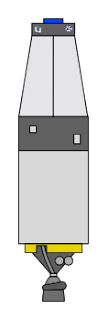In Space Agency you can only access one part of a vehicle, even if the vehicle is built up out of multiple parts. Normally this isn't a problem for most vehicles, like the Orion, because the cargo is stored in the first part, not the second. The service module just expands the fuel capacity and adds a main engine. However, the LOK crew module and the Draco trunk are exceptions. Both of these cargo carrying parts are used in multi-part vehicles, and are typically not the top vehicle. This means that their cargo area can't have items removed from it. This makes the Draco trunk useless as a way to transport additional cargo, and the LOK will always have a limited atmosphere supply.
As a fix to this Centauri Spaceworks interface designers propose making the cargo panel scroll-able and adding in additional sections for each part that can contain cargo. This would allow access to the Draco trunk and the LOK crew module.
The images below illustrate a potential solution. The LOK modules only have three cargo slots but the images show eight to validate that this interface could handle any sized module. The first image shows the first module in the vehicle. You can see that there is an additional section below. There up and down arrows that can be tapped or dragged to move between the sections.
The second image shows the cargo view of a subsequent module. The initial module's cargo segment has been scrolled up.
All of the pilots and engineers at Centauri Spaceworks hope that Nooleus will implement this solution, or some solution to the problems with the LOK and Draco trunk in the next update.
Update: The original post proposed scrolling left and right, but was later updated to scroll up and down.
Update: The original post proposed scrolling left and right, but was later updated to scroll up and down.













